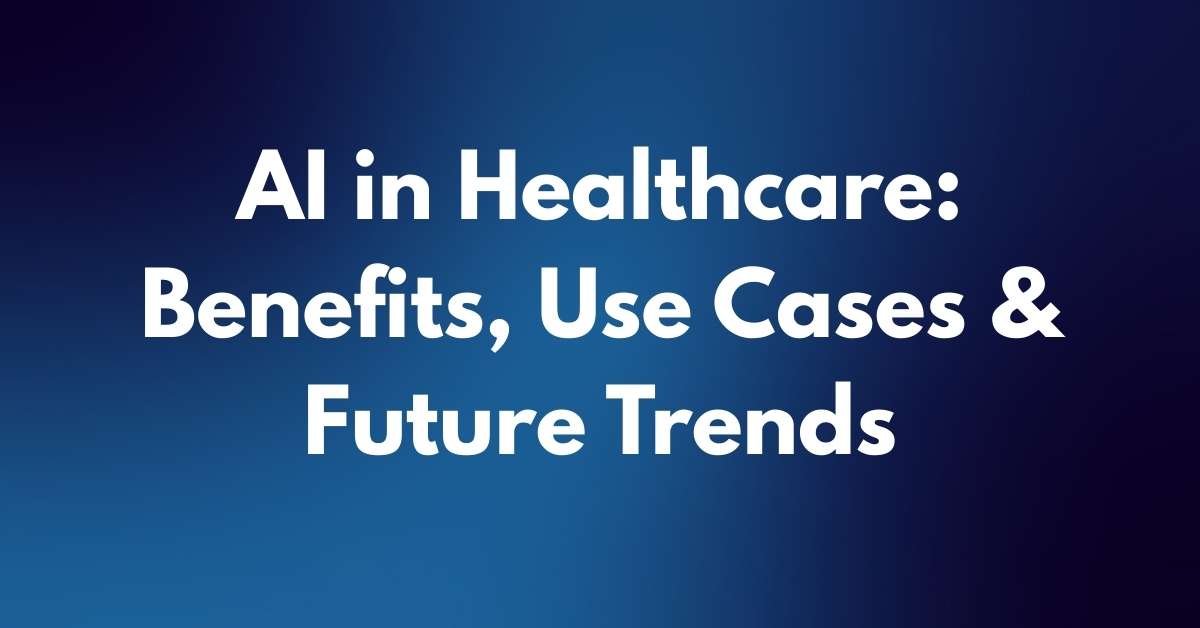Artificial Intelligence is redefining how healthcare systems work. From faster diagnoses to personalized treatment plans, AI is turning once-complex medical challenges into manageable tasks. Hospitals, clinics, and digital health startups are adopting AI to improve outcomes, cut costs, and streamline operations.
Behind this progress is a growing demand for strategic AI Healthcare Solutions Development. These solutions are designed to work within real clinical workflows, solving specific problems with precision and speed. The result is smarter care, delivered faster and more efficiently across every stage of the patient journey.
This article explores the most impactful use cases of AI in healthcare, backed by real-world examples, measurable benefits, and insights into what the future holds. Whether you’re a provider, policymaker, or health tech innovator, this guide will help you understand where AI fits and how to make the most of it.
Use Cases of AI in Healthcare
AI is transforming healthcare across diagnostics, treatment, patient support, and system management. Its applications are not only theoretical, they’re being used daily in hospitals, labs, and even patient homes. Here are the top real-world AI use cases making a measurable difference in how healthcare is delivered.
1. AI in Medical Imaging and Diagnostics
AI is changing how doctors interpret scans by automatically analyzing X-rays, MRIs, and CT images. These systems can detect conditions like tumors, fractures, and lung infections with high speed and precision. They don’t replace radiologists but assist them in reducing oversight and improving early detection. As a result, patients get quicker and more accurate diagnoses.
Example: Google DeepMind built an AI model that diagnoses over 50 eye diseases with the accuracy of top ophthalmologists.
Impact: Breast cancer screening with AI support has shown a 30 percent drop in false negatives and faster turnaround times.
2. Predictive Analytics and Risk Scoring
AI systems can forecast health risks before symptoms appear by analyzing patient data in real time. These models use medical history, lab results, and current vitals to predict emergencies like heart failure or sepsis. By alerting doctors early, they enable proactive intervention and save lives. This makes care more timely and efficient for high-risk patients.
Example: Mount Sinai uses AI to predict heart failure 24–48 hours before critical symptoms emerge.
Impact: Predictive analytics has helped hospitals reduce preventable ICU admissions by up to 40 percent.
3. Virtual Health Assistants and AI Chatbots
AI chatbots and virtual assistants handle routine tasks like symptom checks, appointment scheduling, and patient education. Available 24/7, they improve access to care and reduce administrative burdens on staff. These tools use natural language to guide users through health queries in real time. They’re especially helpful in managing high patient volumes and non-emergency needs.
Example: Babylon Health’s AI chatbot supports millions of users with triage and medical advice across the UK.
Impact: Clinics using virtual assistants report up to 30 percent less inbound call volume and shorter response times.
4. AI in Drug Discovery and Development
Drug discovery is a slow, expensive process — but AI can dramatically speed it up. By analyzing molecular structures, genetics, and disease pathways, AI identifies promising drug candidates faster than traditional methods. It also predicts how drugs will interact with the human body, reducing trial failures. This makes research more focused, faster, and cost-effective.
Example: BenevolentAI identified a COVID-19 treatment candidate in just 48 hours using AI models.
Impact: AI can cut drug development costs by as much as 70 percent and reduce research timelines from years to months.
5. Personalized Treatment Planning
AI enables truly personalized medicine by recommending treatments based on a patient’s unique profile. It considers genetics, past responses to medications, and lifestyle factors to guide clinical decisions. This increases treatment effectiveness and minimizes side effects. Patients benefit from care that’s tailored to their individual needs, not generic protocols.
Example: IBM Watson for Oncology analyzes patient records and literature to suggest personalized cancer treatment options.
Impact: Clinics using AI-assisted decision tools report better treatment adherence and more precise care strategies.
6. Hospital Operations and Workflow Optimization
AI streamlines hospital operations by managing bed availability, staffing, and patient flow. It predicts discharge times and optimizes schedules to reduce delays and improve resource use. This operational intelligence leads to smoother workflows, reduced bottlenecks, and better patient experiences. It also lowers administrative overhead for hospital managers.
Example: Cleveland Clinic uses AI to track admissions and discharges, optimizing bed usage in real time.
Impact: AI-led process improvements have cut average inpatient stay by up to 15 percent and boosted bed turnover efficiency.
7. Remote Monitoring and Chronic Disease Management
Patients with chronic conditions like diabetes, heart disease, or COPD benefit from AI-powered remote monitoring. AI analyzes real-time data from wearables and mobile apps to track symptoms and alert care teams. This keeps patients healthier at home and reduces emergency visits. It also gives clinicians a continuous view of their patients’ conditions.
Example: Livongo uses AI and connected devices to help diabetes patients manage blood sugar with real-time coaching.
Impact: Users experienced 25 percent improvement in glucose control and reduced hospitalizations.
8. AI in Mental Health Support
Mental health apps are now using AI to provide accessible, stigma-free support. These tools guide users through cognitive behavioral therapy (CBT), detect mood changes, and offer real-time emotional coaching. They work as first-line support for stress, anxiety, or depression. AI fills gaps where human therapists are unavailable or costly.
Example: Wysa offers AI-based CBT tools that engage users in chat-based therapy with personalized suggestions.
Impact: Programs using AI have reported 30 percent higher engagement in therapy, especially among youth and remote users.
9. Public Health Surveillance and Disease Tracking
AI systems analyze global data from news, social media, and travel to detect disease outbreaks early. These tools spot trends that human analysts might miss, offering rapid alerts to health authorities. Faster identification means quicker containment and better planning. AI strengthens public health response before crises escalate.
Example: BlueDot flagged the COVID-19 outbreak in Wuhan days before the World Health Organization’s official warning.
Impact: Early detection using AI can improve response speed by 40 percent, saving thousands of lives during pandemics.
10. Medical Documentation and EHR Automation
Doctors spend hours each day on documentation — AI helps cut that time in half. Using speech-to-text and natural language processing, it captures clinical notes automatically. These systems integrate with electronic health records (EHRs), making data entry faster and more accurate. Doctors can focus more on patients and less on paperwork.
Example: Nuance’s Dragon Medical One converts spoken notes into structured EHR data during appointments.
Impact: Clinicians using AI note-taking tools save up to 50 percent of their time and experience less burnout.
Benefits and Impact of AI in Healthcare
AI is doing more than automating tasks; it’s helping save lives, streamline care, and cut costs across the board. Let’s explore the five most transformative benefits of AI in real-world healthcare settings.
1. Faster and More Accurate Diagnoses
AI quickly scans medical images, lab results, and patient data to detect patterns that doctors might miss. It reduces diagnostic delays and errors, especially in radiology, pathology, and dermatology. This speed helps initiate treatment faster, which can improve patient outcomes significantly.
Hospitals using AI for imaging have reported a 30 percent drop in missed cancer diagnoses. By assisting, not replacing, specialists, AI gives clinicians a second set of eyes, one that never gets tired and keeps learning from every case.
2. Early Detection and Preventive Care
AI can identify subtle risk factors and alert doctors before symptoms even appear. It uses predictive models built from thousands of patient records to forecast chronic conditions like heart failure or diabetes. This helps providers shift from reactive care to prevention.
At Mount Sinai, predictive AI flagged high-risk cardiac patients up to 48 hours in advance. These early warnings enabled quicker interventions, reducing ICU transfers and improving survival rates. Early detection means fewer emergencies and better quality of life for patients.
3. Improved Hospital Operations and Efficiency
AI helps hospitals run smarter by predicting patient flow, optimizing schedules, and managing staff resources. It prevents overcrowding, shortens wait times, and keeps care delivery organized. That means less chaos and more focus on patients.
For example, Cleveland Clinic uses AI to predict discharges and streamline bed usage. This has reduced inpatient stay times by up to 15 percent. Hospitals save money and staff experience less burnout when operations run smoothly.
4. More Personalized Treatment Plans
AI analyzes patient histories, genetics, and lifestyle data to recommend treatments tailored to the individual. It moves healthcare away from one-size-fits-all approaches and toward precision medicine. The result is better responses to treatment and fewer side effects.
In cancer care, AI tools like IBM Watson for Oncology suggest therapies backed by clinical research. These recommendations help oncologists create highly targeted plans, improving patient confidence and treatment success rates.
5. Expanded Access to Healthcare
AI-powered chatbots, mobile apps, and remote monitoring tools bring healthcare to people who can’t easily visit a doctor. This includes rural populations, the elderly, and patients with mobility challenges. Digital access reduces travel, costs, and wait times.
In India and China, AI health platforms like Ping An Good Doctor and Apollo’s Health Check use AI to serve millions. They offer fast, affordable care to people who previously had limited options, a game-changer for public health equity.
Challenges, Risks, and Ethical Considerations
AI in healthcare offers powerful tools, but it also introduces real concerns. The biggest challenge is data bias. If the training data lacks diversity, AI may perform poorly for certain groups. This can lead to inaccurate diagnoses or unequal care, especially in underrepresented populations.
Transparency is another concern. Many AI models are complex and hard to interpret, leaving doctors unsure how the system reached a conclusion. In healthcare, where lives are on the line, professionals need clear reasoning behind every decision. Trust grows only when AI tools are explainable and accountable.
Finally, there is the issue of privacy and legal responsibility. AI systems rely on sensitive health data, raising the risk of breaches or misuse. At the same time, laws have not kept pace. If an AI system causes harm, it is often unclear who is liable the doctor, the hospital, or the tech provider.
Future Trends of AI in Healthcare
AI is evolving rapidly, and its role in healthcare will grow far beyond diagnostics and automation. One major trend is the rise of generative AI, which can create clinical notes, summarize patient records, and even simulate virtual patients for training. These tools help reduce administrative overload and support faster decision-making.
Another key trend is the growth of digital twins and personalized simulations. In the near future, doctors may use AI to model a patient’s unique physiology and test treatments virtually before applying them in real life. This opens the door to safer, more tailored care that adapts in real time.
AI will also play a bigger role in global health and remote care delivery. Smart devices, language-adaptive chatbots, and low-bandwidth AI models will help reach populations with limited access to doctors. As technology becomes more affordable and scalable, AI will become a foundation of care in both high-tech hospitals and underserved communities.
Conclusion
AI is no longer a futuristic concept in healthcare. It is already transforming how we diagnose, treat, and manage patients. From improving diagnostic accuracy to making care more personalized and accessible, AI is driving meaningful change across the entire system.
But with innovation comes responsibility. Healthcare providers must adopt AI thoughtfully, ensuring ethical standards, data privacy, and fairness for all patients. Success lies in blending human expertise with machine intelligence, not replacing one with the other.
As AI continues to evolve, its impact will deepen. Organizations that embrace this shift with strategy, care, and collaboration will lead the way in delivering faster, smarter, and more equitable healthcare. If you are exploring how to implement AI effectively, consider partnering with a trusted AI in healthcare service to ensure your journey starts with clarity and confidence.



